Abstract
Vaccination with synthetic peptides representing cytotoxic T lymphocyte (CTL) epitopes can lead to a protective CTL-mediated immunity against tumors or viruses. We now report that vaccination with a CTL epitope derived from the human adenovirus type 5 E1A-region (Ad5E1A234-243), which can serve as a target for tumor-eradicating CTL, enhances rather than inhibits the growth of Ad5E1A-expressing tumors. This adverse effect of peptide vaccination was rapidly evoked, required low doses of peptide (10 micrograms), and was achieved by a mode of peptide delivery that induces protective T-cell-mediated immunity in other models. Ad5E1A-specific CTL activity could no longer be isolated from mice after injection of Ad5E1A-peptide, indicating that tolerization of Ad5E1A-specific CTL activity causes the enhanced tumor outgrowth. In contrast to peptide vaccination, immunization with adenovirus, expressing Ad5E1A, induced Ad5E1A-specific immunity and prevented the outgrowth of Ad5E1A-expressing tumors. These results show that immunization with synthetic peptides can lead to the elimination of anti-tumor CTL responses. These findings are important for the design of safe peptide-based vaccines against tumors, allogeneic organ transplants, and T-cell-mediated autoimmune diseases.
Full text
PDF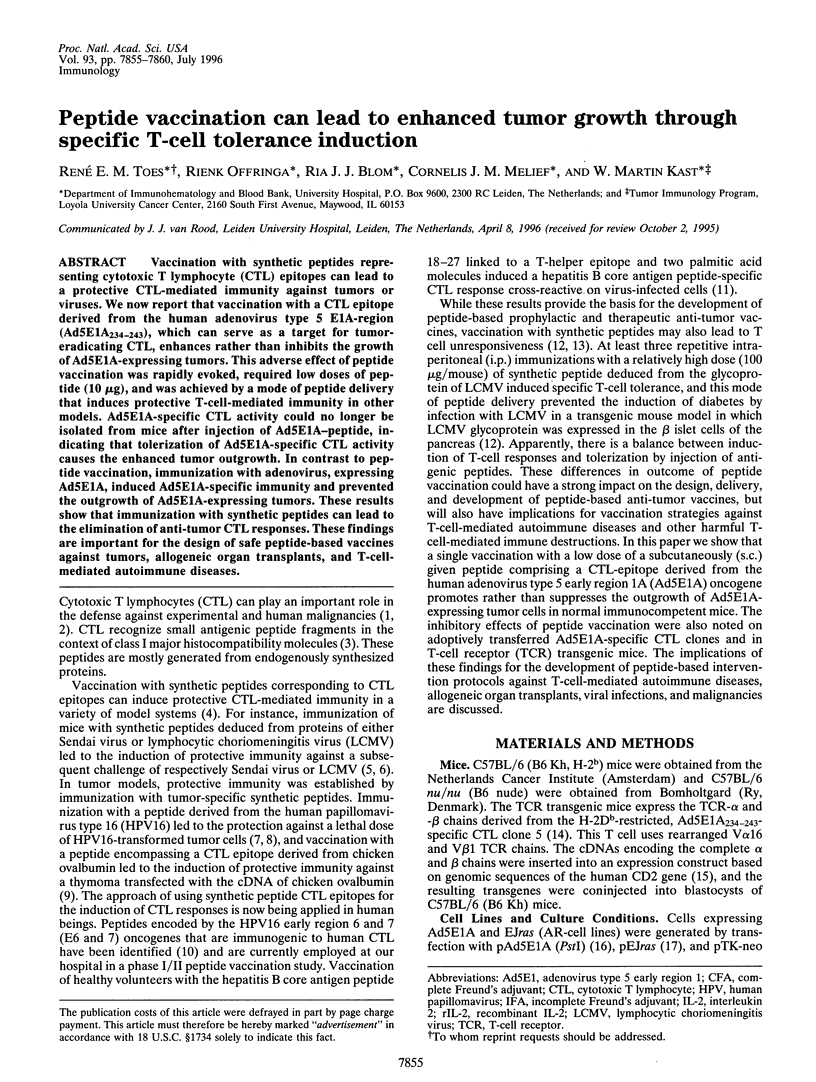
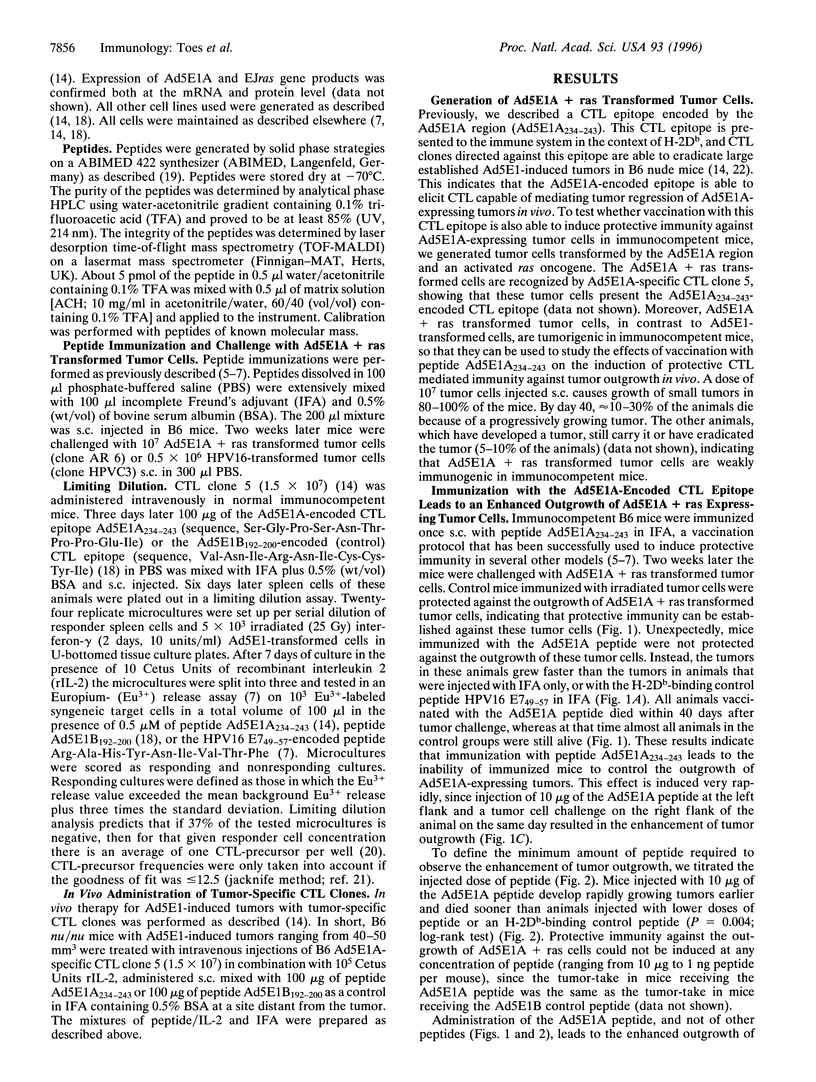
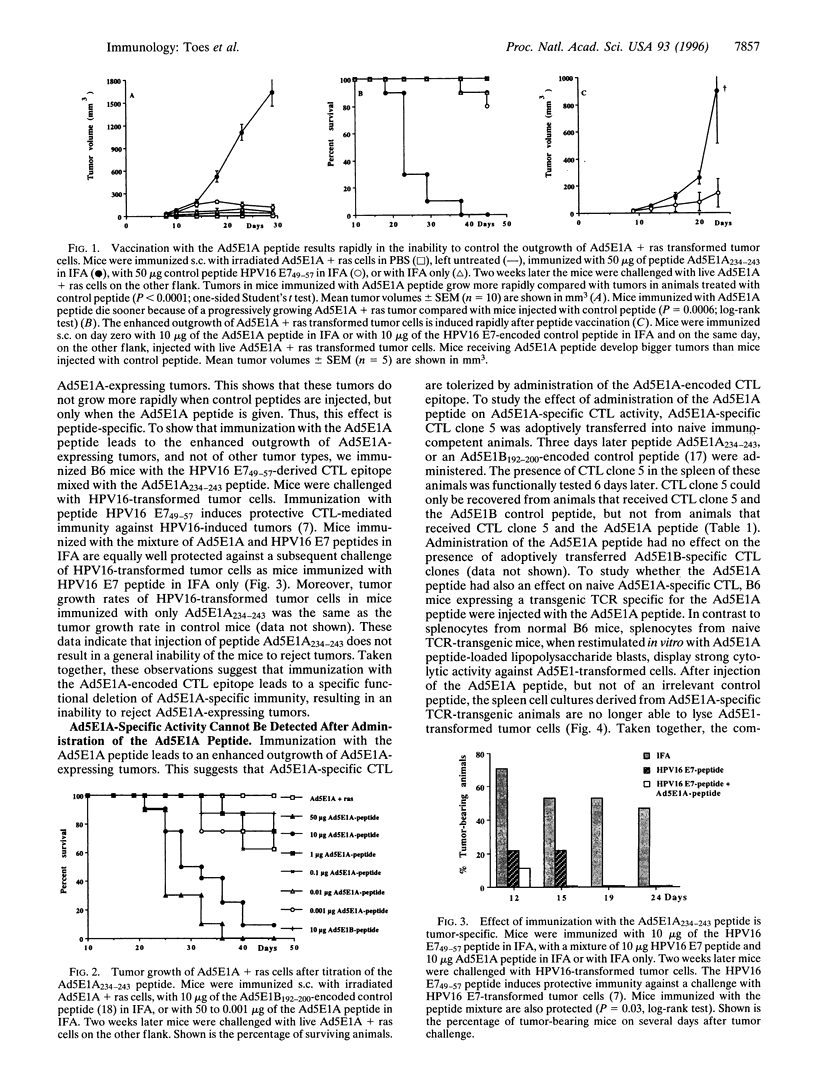
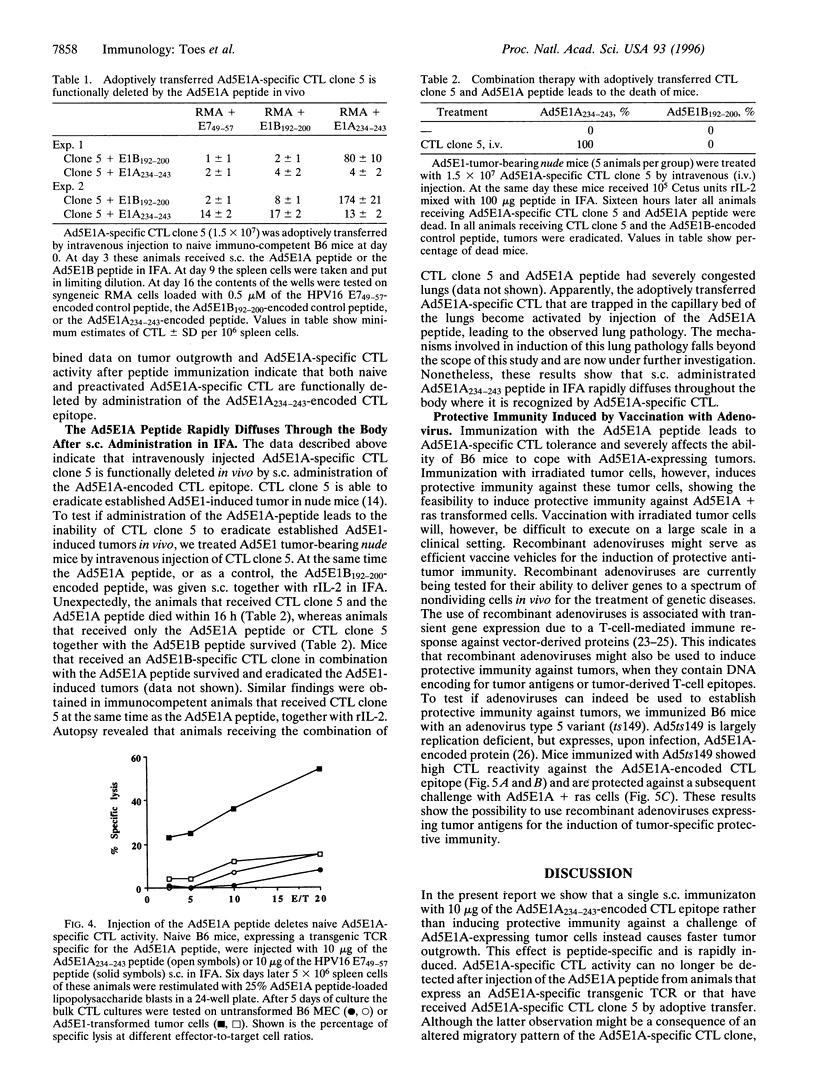
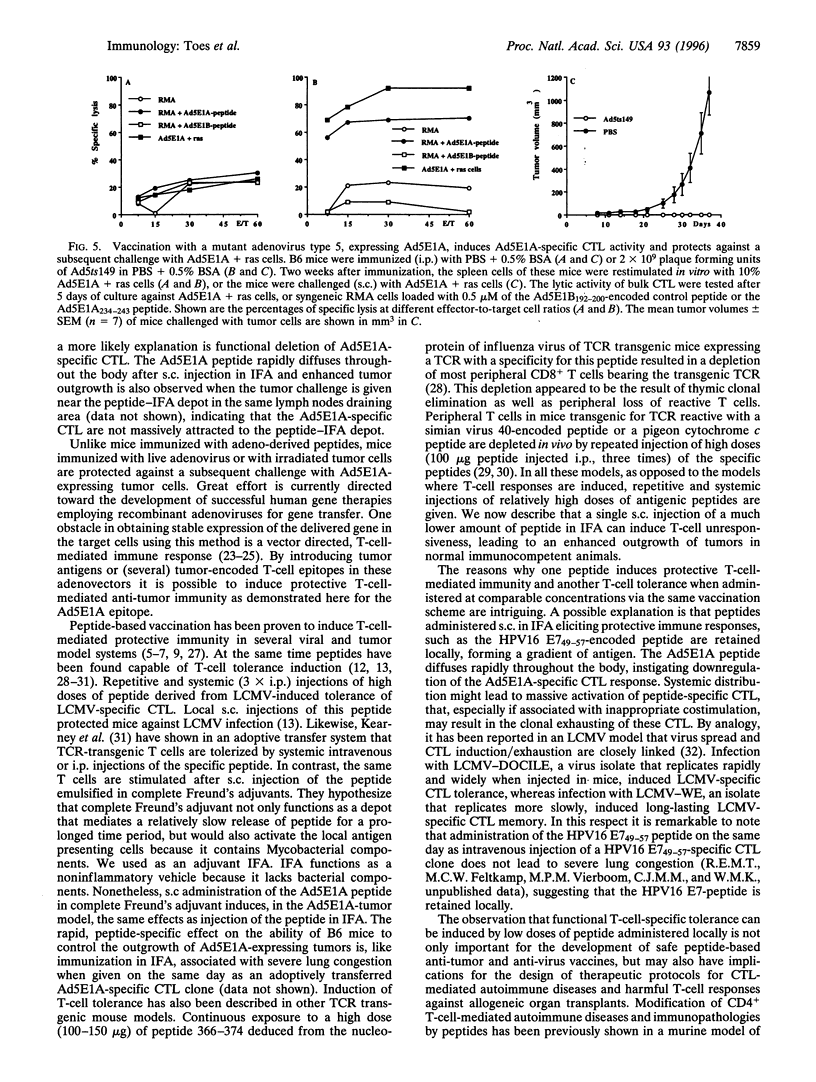
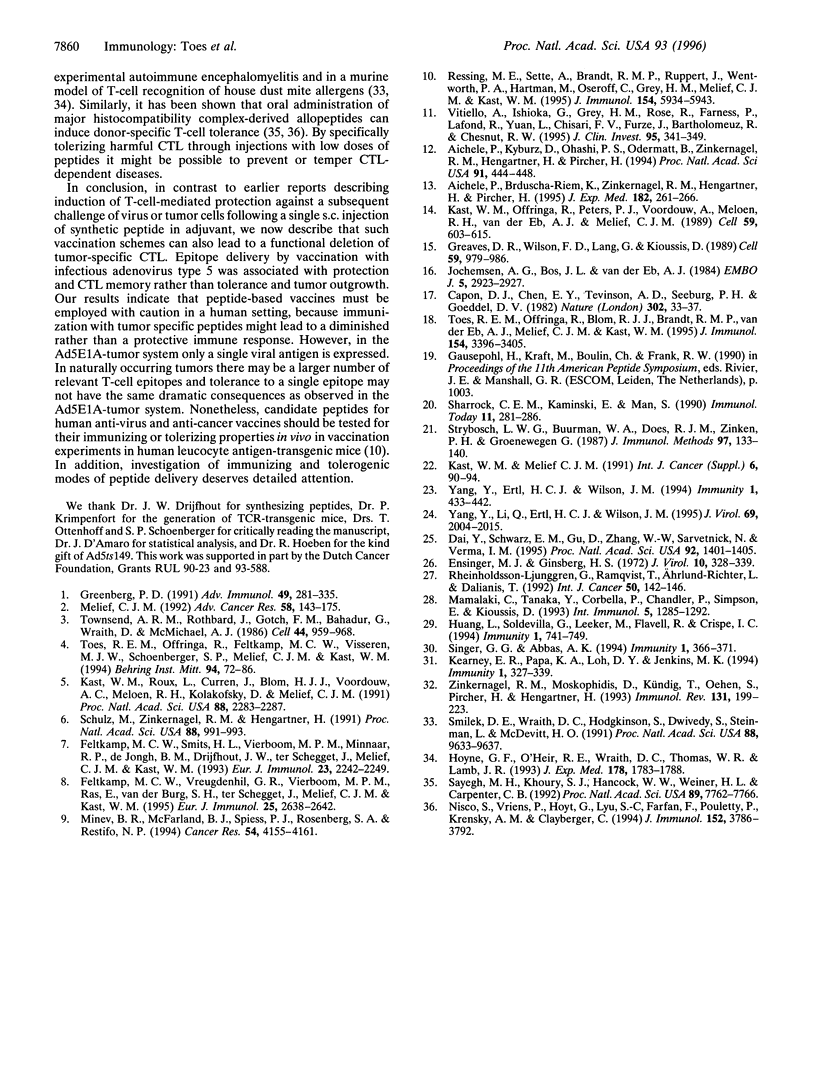
Images in this article
Selected References
These references are in PubMed. This may not be the complete list of references from this article.
- Aichele P., Brduscha-Riem K., Zinkernagel R. M., Hengartner H., Pircher H. T cell priming versus T cell tolerance induced by synthetic peptides. J Exp Med. 1995 Jul 1;182(1):261–266. doi: 10.1084/jem.182.1.261. [DOI] [PMC free article] [PubMed] [Google Scholar]
- Aichele P., Kyburz D., Ohashi P. S., Odermatt B., Zinkernagel R. M., Hengartner H., Pircher H. Peptide-induced T-cell tolerance to prevent autoimmune diabetes in a transgenic mouse model. Proc Natl Acad Sci U S A. 1994 Jan 18;91(2):444–448. doi: 10.1073/pnas.91.2.444. [DOI] [PMC free article] [PubMed] [Google Scholar]
- Capon D. J., Chen E. Y., Levinson A. D., Seeburg P. H., Goeddel D. V. Complete nucleotide sequences of the T24 human bladder carcinoma oncogene and its normal homologue. Nature. 1983 Mar 3;302(5903):33–37. doi: 10.1038/302033a0. [DOI] [PubMed] [Google Scholar]
- Dai Y., Schwarz E. M., Gu D., Zhang W. W., Sarvetnick N., Verma I. M. Cellular and humoral immune responses to adenoviral vectors containing factor IX gene: tolerization of factor IX and vector antigens allows for long-term expression. Proc Natl Acad Sci U S A. 1995 Feb 28;92(5):1401–1405. doi: 10.1073/pnas.92.5.1401. [DOI] [PMC free article] [PubMed] [Google Scholar]
- Ensinger M. J., Ginsberg H. S. Selection and preliminary characterization of temperature-sensitive mutants of type 5 adenovirus. J Virol. 1972 Sep;10(3):328–339. doi: 10.1128/jvi.10.3.328-339.1972. [DOI] [PMC free article] [PubMed] [Google Scholar]
- Feltkamp M. C., Smits H. L., Vierboom M. P., Minnaar R. P., de Jongh B. M., Drijfhout J. W., ter Schegget J., Melief C. J., Kast W. M. Vaccination with cytotoxic T lymphocyte epitope-containing peptide protects against a tumor induced by human papillomavirus type 16-transformed cells. Eur J Immunol. 1993 Sep;23(9):2242–2249. doi: 10.1002/eji.1830230929. [DOI] [PubMed] [Google Scholar]
- Feltkamp M. C., Vreugdenhil G. R., Vierboom M. P., Ras E., van der Burg S. H., ter Schegget J., Melief C. J., Kast W. M. Cytotoxic T lymphocytes raised against a subdominant epitope offered as a synthetic peptide eradicate human papillomavirus type 16-induced tumors. Eur J Immunol. 1995 Sep;25(9):2638–2642. doi: 10.1002/eji.1830250935. [DOI] [PubMed] [Google Scholar]
- Greaves D. R., Wilson F. D., Lang G., Kioussis D. Human CD2 3'-flanking sequences confer high-level, T cell-specific, position-independent gene expression in transgenic mice. Cell. 1989 Mar 24;56(6):979–986. doi: 10.1016/0092-8674(89)90631-4. [DOI] [PubMed] [Google Scholar]
- Greenberg P. D. Adoptive T cell therapy of tumors: mechanisms operative in the recognition and elimination of tumor cells. Adv Immunol. 1991;49:281–355. doi: 10.1016/s0065-2776(08)60778-6. [DOI] [PubMed] [Google Scholar]
- Hoyne G. F., O'Hehir R. E., Wraith D. C., Thomas W. R., Lamb J. R. Inhibition of T cell and antibody responses to house dust mite allergen by inhalation of the dominant T cell epitope in naive and sensitized mice. J Exp Med. 1993 Nov 1;178(5):1783–1788. doi: 10.1084/jem.178.5.1783. [DOI] [PMC free article] [PubMed] [Google Scholar]
- Huang L., Soldevila G., Leeker M., Flavell R., Crispe I. N. The liver eliminates T cells undergoing antigen-triggered apoptosis in vivo. Immunity. 1994 Dec;1(9):741–749. doi: 10.1016/s1074-7613(94)80016-2. [DOI] [PubMed] [Google Scholar]
- Jochemsen A. G., Bos J. L., van der Eb A. J. The first exon of region E1a genes of adenoviruses 5 and 12 encodes a separate functional protein domain. EMBO J. 1984 Dec 1;3(12):2923–2927. doi: 10.1002/j.1460-2075.1984.tb02233.x. [DOI] [PMC free article] [PubMed] [Google Scholar]
- Kast W. M., Melief C. J. Fine peptide specificity of cytotoxic T lymphocytes directed against adenovirus-induced tumours and peptide-MHC binding. Int J Cancer Suppl. 1991;6:90–94. doi: 10.1002/ijc.2910470718. [DOI] [PubMed] [Google Scholar]
- Kast W. M., Offringa R., Peters P. J., Voordouw A. C., Meloen R. H., van der Eb A. J., Melief C. J. Eradication of adenovirus E1-induced tumors by E1A-specific cytotoxic T lymphocytes. Cell. 1989 Nov 17;59(4):603–614. doi: 10.1016/0092-8674(89)90006-8. [DOI] [PubMed] [Google Scholar]
- Kast W. M., Roux L., Curren J., Blom H. J., Voordouw A. C., Meloen R. H., Kolakofsky D., Melief C. J. Protection against lethal Sendai virus infection by in vivo priming of virus-specific cytotoxic T lymphocytes with a free synthetic peptide. Proc Natl Acad Sci U S A. 1991 Mar 15;88(6):2283–2287. doi: 10.1073/pnas.88.6.2283. [DOI] [PMC free article] [PubMed] [Google Scholar]
- Kearney E. R., Pape K. A., Loh D. Y., Jenkins M. K. Visualization of peptide-specific T cell immunity and peripheral tolerance induction in vivo. Immunity. 1994 Jul;1(4):327–339. doi: 10.1016/1074-7613(94)90084-1. [DOI] [PubMed] [Google Scholar]
- Mamalaki C., Tanaka Y., Corbella P., Chandler P., Simpson E., Kioussis D. T cell deletion follows chronic antigen specific T cell activation in vivo. Int Immunol. 1993 Oct;5(10):1285–1292. doi: 10.1093/intimm/5.10.1285. [DOI] [PubMed] [Google Scholar]
- Melief C. J. Tumor eradication by adoptive transfer of cytotoxic T lymphocytes. Adv Cancer Res. 1992;58:143–175. doi: 10.1016/s0065-230x(08)60294-8. [DOI] [PubMed] [Google Scholar]
- Minev B. R., McFarland B. J., Spiess P. J., Rosenberg S. A., Restifo N. P. Insertion signal sequence fused to minimal peptides elicits specific CD8+ T-cell responses and prolongs survival of thymoma-bearing mice. Cancer Res. 1994 Aug 1;54(15):4155–4161. [PMC free article] [PubMed] [Google Scholar]
- Nisco S., Vriens P., Hoyt G., Lyu S. C., Farfan F., Pouletty P., Krensky A. M., Clayberger C. Induction of allograft tolerance in rats by an HLA class-I-derived peptide and cyclosporine A. J Immunol. 1994 Apr 15;152(8):3786–3792. [PubMed] [Google Scholar]
- Reinholdsson-Ljunggren G., Ramqvist T., Ahrlund-Richter L., Dalianis T. Immunization against polyoma tumors with synthetic peptides derived from the sequences of middle- and large-T antigens. Int J Cancer. 1992 Jan 2;50(1):142–146. doi: 10.1002/ijc.2910500128. [DOI] [PubMed] [Google Scholar]
- Ressing M. E., Sette A., Brandt R. M., Ruppert J., Wentworth P. A., Hartman M., Oseroff C., Grey H. M., Melief C. J., Kast W. M. Human CTL epitopes encoded by human papillomavirus type 16 E6 and E7 identified through in vivo and in vitro immunogenicity studies of HLA-A*0201-binding peptides. J Immunol. 1995 Jun 1;154(11):5934–5943. [PubMed] [Google Scholar]
- Sayegh M. H., Khoury S. J., Hancock W. W., Weiner H. L., Carpenter C. B. Induction of immunity and oral tolerance with polymorphic class II major histocompatibility complex allopeptides in the rat. Proc Natl Acad Sci U S A. 1992 Aug 15;89(16):7762–7766. doi: 10.1073/pnas.89.16.7762. [DOI] [PMC free article] [PubMed] [Google Scholar]
- Schulz M., Zinkernagel R. M., Hengartner H. Peptide-induced antiviral protection by cytotoxic T cells. Proc Natl Acad Sci U S A. 1991 Feb 1;88(3):991–993. doi: 10.1073/pnas.88.3.991. [DOI] [PMC free article] [PubMed] [Google Scholar]
- Sharrock C. E., Kaminski E., Man S. Limiting dilution analysis of human T cells: a useful clinical tool. Immunol Today. 1990 Aug;11(8):281–286. doi: 10.1016/0167-5699(90)90113-n. [DOI] [PubMed] [Google Scholar]
- Singer G. G., Abbas A. K. The fas antigen is involved in peripheral but not thymic deletion of T lymphocytes in T cell receptor transgenic mice. Immunity. 1994 Aug;1(5):365–371. doi: 10.1016/1074-7613(94)90067-1. [DOI] [PubMed] [Google Scholar]
- Smilek D. E., Wraith D. C., Hodgkinson S., Dwivedy S., Steinman L., McDevitt H. O. A single amino acid change in a myelin basic protein peptide confers the capacity to prevent rather than induce experimental autoimmune encephalomyelitis. Proc Natl Acad Sci U S A. 1991 Nov 1;88(21):9633–9637. doi: 10.1073/pnas.88.21.9633. [DOI] [PMC free article] [PubMed] [Google Scholar]
- Strijbosch L. W., Buurman W. A., Does R. J., Zinken P. H., Groenewegen G. Limiting dilution assays. Experimental design and statistical analysis. J Immunol Methods. 1987 Feb 26;97(1):133–140. doi: 10.1016/0022-1759(87)90115-3. [DOI] [PubMed] [Google Scholar]
- Toes R. E., Offringa R., Blom R. J., Brandt R. M., van der Eb A. J., Melief C. J., Kast W. M. An adenovirus type 5 early region 1B-encoded CTL epitope-mediating tumor eradication by CTL clones is down-modulated by an activated ras oncogene. J Immunol. 1995 Apr 1;154(7):3396–3405. [PubMed] [Google Scholar]
- Toes R. E., Offringa R., Feltkamp M. C., Visseren M. J., Schoenberger S. P., Melief C. J., Kast W. M. Tumor rejection antigens and tumor specific cytotoxic T lymphocytes. Behring Inst Mitt. 1994 Jul;(94):72–86. [PubMed] [Google Scholar]
- Townsend A. R., Rothbard J., Gotch F. M., Bahadur G., Wraith D., McMichael A. J. The epitopes of influenza nucleoprotein recognized by cytotoxic T lymphocytes can be defined with short synthetic peptides. Cell. 1986 Mar 28;44(6):959–968. doi: 10.1016/0092-8674(86)90019-x. [DOI] [PubMed] [Google Scholar]
- Vitiello A., Ishioka G., Grey H. M., Rose R., Farness P., LaFond R., Yuan L., Chisari F. V., Furze J., Bartholomeuz R. Development of a lipopeptide-based therapeutic vaccine to treat chronic HBV infection. I. Induction of a primary cytotoxic T lymphocyte response in humans. J Clin Invest. 1995 Jan;95(1):341–349. doi: 10.1172/JCI117662. [DOI] [PMC free article] [PubMed] [Google Scholar]
- Yang Y., Ertl H. C., Wilson J. M. MHC class I-restricted cytotoxic T lymphocytes to viral antigens destroy hepatocytes in mice infected with E1-deleted recombinant adenoviruses. Immunity. 1994 Aug;1(5):433–442. doi: 10.1016/1074-7613(94)90074-4. [DOI] [PubMed] [Google Scholar]
- Yang Y., Li Q., Ertl H. C., Wilson J. M. Cellular and humoral immune responses to viral antigens create barriers to lung-directed gene therapy with recombinant adenoviruses. J Virol. 1995 Apr;69(4):2004–2015. doi: 10.1128/jvi.69.4.2004-2015.1995. [DOI] [PMC free article] [PubMed] [Google Scholar]
- Zinkernagel R. M., Moskophidis D., Kündig T., Oehen S., Pircher H., Hengartner H. Effector T-cell induction and T-cell memory versus peripheral deletion of T cells. Immunol Rev. 1993 Jun;133:199–223. doi: 10.1111/j.1600-065x.1993.tb01517.x. [DOI] [PubMed] [Google Scholar]



